The Saga of the Risen Phoenix
by Bill Pronzini
Norma Goold was the most beautiful corpse Allen Starke had ever
beheld. When he had seen her, lithe and young and magnetically
compelling, doing her number at The Gayety burlesque house a few hours
previously, he had understood his friend Paul Cloud’s infatuation with
her. And even in death the power she had over men continued.
Paul Cloud, and his whole family with him, was drawn into the net of suspicion spread as a result of Norma’s violent demise. So was Paul’s fiancée, and the playboy backer of The Gayety, and an Italian gambler who had known La Goold when her name had been plain Marcella Cadorna. And before it all ended, Allen wished he had never left Kentucky’s peaceful blue grass for New Orleans. – Jacket
blurb for Death for the Lady,
by Stewart Vanderveer, Phoenix Press.
Once upon a time, in the kingdom of New York, there was a publishing company called Phoenix Press. Like many others born during the Great Depression, Phoenix was a lending-library publisher, which is to say that it grew up in a very tough and competitive neighborhood and was often forced to fight for survival with other lending-library publishers –Godwin, Greenberg, Arcadia – that operated in the same ghetto. Phoenix’s parentage is unknown. Perhaps it had no parentage in the conventional sense; perhaps it simply sprang from the ashes of some defunct flapper-era publisher, youthfully alive and functional, ready to do battle in the marketplace. Such is the stuff of legends and fairy tales. But Phoenix Press was stronger and more dedicated than the other lending-library publishers, and soon it surpassed them all to become the strongest in the kingdom. Guided by the keen eyes and iron hearts of its two chief editorial wizards, Emmanuel Wartels and Alice Sachs, it produced more mysteries, Westerns, and light romances during the thirties and forties than any other house. It was surely the monarch of all lending-library publishers everywhere. This, however, was not its greatest distinction. Rather, it is the fact that in less than twenty years, Phoenix published almost as many wonderfully bad novels as all the other publishers combined. The reason behind this remarkable achievement was an unstinting devotion to the principles of capitalistic free enterprise. Or to put it another way, it was a matter of greed. Phoenix published a large quantity of books and yet paid absolute minimum royalties to its writers. In an article for the Writer’s 1941 Year Book, novelist and screenwriter Steve Fisher says that he received the handsome sum of $125 for all rights to his first novel, Spend the Night, in 1935. Rates escalated dramatically to $300 for all rights – and even to $500 for some of Phoenix’s more prolific contributors –in the late thirties; where they remained for many years to come. This policy of paying rock-bottom prices allowed Phoenix to buy manuscripts that had been rejected by the major publishers and by some of the other lending-library outfits as well. And the preponderance of these manuscripts were, to put it in charitable terms, only marginally publishable by most standards. Thus, by a combination of design and accident, were so many classics given life in the kingdom. 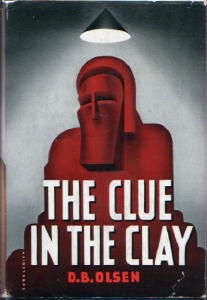 Perhaps providentially,
the reign of the Phoenix was
fated to be short. It had barely reached the age of legal
majority – eighteen – when rising printing costs, the paperback boom of
the early fifties, and the closing of a substantial percentage of small
lending-library outlets toppled the Phoenix empire into the ashes from
whence it came. This is not to say that it died; it was denied
the noble end of death. Instead it was consolidated with Arcadia
House, one of its archrivals, under the Arcadia imprint in 1952.
Even its primary editorial wizard, Alice Sachs, was absorbed in the
merger and assumed command of Arcadia’s line of Westerns and
(increasingly fewer) mysteries until the early sixties. Ms. Sachs
even managed to survive an outright sale of the firm at that time, when
it underwent another metamorphosis into Lenox Hill Press; she rather
amazingly continues to the time of this writing [1982] as Lenox Hill’s
senior editor, holding forth at the same old Phoenix address in New
York City, 419 Fourth Avenue, and still buying light romance
fiction. (Lenox Hill – not to be confused, incidentally, with the
academic publisher of the same name – has never published a regular
mystery line and abandoned its long-standing series of Westerns in
1975. Still, the company manages to survive as the last link to a
vanished era and a vanished publishing kingdom– the sole heir to what
was once a lending-library fortune.) Perhaps providentially,
the reign of the Phoenix was
fated to be short. It had barely reached the age of legal
majority – eighteen – when rising printing costs, the paperback boom of
the early fifties, and the closing of a substantial percentage of small
lending-library outlets toppled the Phoenix empire into the ashes from
whence it came. This is not to say that it died; it was denied
the noble end of death. Instead it was consolidated with Arcadia
House, one of its archrivals, under the Arcadia imprint in 1952.
Even its primary editorial wizard, Alice Sachs, was absorbed in the
merger and assumed command of Arcadia’s line of Westerns and
(increasingly fewer) mysteries until the early sixties. Ms. Sachs
even managed to survive an outright sale of the firm at that time, when
it underwent another metamorphosis into Lenox Hill Press; she rather
amazingly continues to the time of this writing [1982] as Lenox Hill’s
senior editor, holding forth at the same old Phoenix address in New
York City, 419 Fourth Avenue, and still buying light romance
fiction. (Lenox Hill – not to be confused, incidentally, with the
academic publisher of the same name – has never published a regular
mystery line and abandoned its long-standing series of Westerns in
1975. Still, the company manages to survive as the last link to a
vanished era and a vanished publishing kingdom– the sole heir to what
was once a lending-library fortune.)Be all of this as it may, the Phoenix legacy– and the Phoenix mystique – of the thirties and forties is still with us today: the books themselves. Even though an average of only two thousand copies of each title were printed, and most surviving books have library date stamps; card pockets; borrowers’ signatures; coffee and other, stranger stains; dog-eared pages; pages defaced by scatological graffiti disguised as readers’ comments; or any combination of these, copies of most titles turn up fairly often in secondhand bookstores and on mail-order book dealers’ lists. As do the cheap but durable paperback reprint editions of several Phoenix titles published just prior to and during World War II by such ephemeral outfits as Atlas, Black Cat, Bleak House, Hangman’s House, Tech House, and Novel Selections, Inc. (which published Mystery Novel Classic, Mystery Novel of the Month, Western Novel of the Month, Adventure Novel of the Month). Phoenix books were surprisingly well packaged. Dust jackets sported attractive artwork, the paper was of good quality, and there were relatively few typographical errors. In their early years, they even used a distinctive colophon for their mysteries, which depicted a smiling Grim Reaper carrying a large scythe cleverly drawn so that it was also a question mark. To read irony into this by speculating that Alice Sachs and her cohorts knew just what sort of books they were unleashing on an unsuspecting public would seem to be a misinterpretation. Such matters as colophon and editorial selection appear to have been guileless. The total number of novels to appear under the Phoenix imprint probably approaches one thousand, with a full third of those being mysteries. Not all of that third can properly be termed alternative classics; even Phoenix Press was not that awesome. But the number that do achieve classic status are quite high – and there are a great many near-misses. Most Phoenix mysteries, classic and nonclassic alike, were written by unknowns; a high percentage, in fact, are first novels. Consider this glittering array of heretofore unrecognized talent: M. G. MacKnutt, E. Spence du Puy, and Virginia van Urk – no doubt pseudonyms adopted by writers who had read other Phoenix books; Arville Nonweiler, K. Alison La Roche, H. Donald Spatz, Helen Joan Hultman, Kelliher Secrist, Oliver Keystone, H. W. Sandberg, M. W. Glidden, L. Morningstar, Gilbert Eldredge, Stewart Vanderveer, Saul Levinson, Addison Simmons, Amelia Reynolds Long, Paul H. Dobbins, Wallace Reed, Minna Bardon, and Robert Portner Koehler. At least two Phoenix “discoveries” did go on to make names for themselves, in and out of the genre. Softcover spy novelist Edward S. Aarons sold his first three mysteries here, under his Edward Ronns pen name – the only three of his early novels he refused to allow to be reissued in modern paperback; he evidently did not want to answer to his public for such youthful sins as The Corpse Hangs High and Murder Money. And well-known editor, publisher, author, and bibliophile William Targ published his only novel with Phoenix, a collaboration with Lewis Herman entitled The Case of Mr. Cassidy (1939). 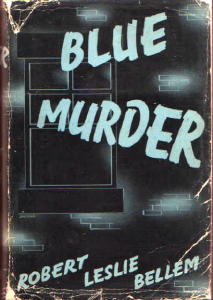 Established writers were also permitted in the Phoenix stable, of course, always provided that they came cheap. Among this group are: Robert Leslie Bellem, whose highly idiomatic pulp work was immortalized in an article by humorist S. J. Perelman and who is being given further recognition later in these pages; his only hardcover novel, Blue Murder, was a 1938 Phoenix selection. Harry Stephen Keeler, the once-popular “wild man” of the mystery, who seems to have been cheerfully daft and whose plots defy logic and the suspension of anyone’s disbelief; several of his later novels found a proper home at 419 Fourth Avenue. Noel Loomis, Mack Reynolds, and William MacLeod Raine, each with a single criminous book. Their efforts are testimony to the fact that writers of some prominence in other genres are not always well advised to try the mystery form. Another interesting facet of Phoenix mysteries was their unique and enticing titles. For example, we have The Case of the Little Green Men, The Case of the 16 Beans, The Case of the Barking Clock, The Case of the Six Bullets, and The Case of the Deadly Drops. Then we have Corpse in the Wind, The Corpse Came Calling, The Corpse Came Back, The Corpse at the Quill Club, and The Corpse With Knee-Action. Next we have Murder Goes to Press, Murder Goes South, Murder Is a Gamble, Murder Is an Art, Murder on Beacon Hill, Murder in the Stratosphere, Murder at Pirate’s Head [this title was not published by Phoenix], Murder at Horsethief, Murder at Coney Island, Red-Hot Murder, The House Cried Murder, The Hooded Vulture Murders, and the provocative Murder Does Light Housekeeping. And finally we have Death After Lunch, Death in the Night, Death in the Dunes, Death on the Cuff, Death Paints a Picture, Death Gets a Head, Death ala King, Death Walks Softly, and Tread Gently, Death. No one has come across it yet, but there has to be a Phoenix book somewhere called The Case of the Corpse Who Was Murdered to Death. Are there truly memorable detectives, professional and amateur, in Phoenix mysteries? Yes indeed. Nowhere else in crime fiction will you find such heroic figures as: Duke Pizzatello, a roscoe-packing, gasper-puffing private dick known to friends and enemies alike as “the wop,” who enjoys getting next to dames almost as much as he enjoys knocking off gunsels with a roscoe that stutters: “Chud-chud-chud-chud!” (Blue Murder, by Robert Leslie Bellem) Paul Plush, a Latin professor in a girls’ school, who stumbles on some poison-pen letters and is nearly poisoned by a murderer, not to mention the poison pen of the author. (Oliver Keystone’s Arsenic for the Teacher) Blackie White, a 5-foot-2-inch private detective “with a body like a tank and the eyes of a baby,” who says things like “Holy suffering mother-in-laws!” when he’s excited. (Philip Johnson’s Hung Until Dead) 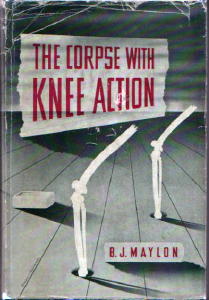 Sheila Coates,
a redheaded taxi danger who is visited by a corpse and subsequently
finds true love – not, fortunately, with the corpse. (Clinton
Bestor’s The Corpse Came Calling) Sheila Coates,
a redheaded taxi danger who is visited by a corpse and subsequently
finds true love – not, fortunately, with the corpse. (Clinton
Bestor’s The Corpse Came Calling)Bill King of the San Francisco Times, who wisecracks his way to the solution of the murder-by-the-severing-of-an-artery-in-the-victim’s-leg. Why such an odd method of murder? The author doesn’t explain it adequately, perhaps because he was something of a knee-jerk writer. (The Corpse with Knee-Action, by B. J. Maylon) Thibault Parew, amateur sleuth and authority on international affairs, archeology, aviation, science, criminology, music, painting, drama, liquor, women, counterespionage, and the well-turned phrase. His favorite saying is “By the shades of the sorrowing Aphrodite!” He also says “Deuced pretty take-off,” and “You’re beauteous, my dear, and extremely lovely,” while solving a couple of impossible (very impossible) murders in a locked airplane. (Murder in the Stratosphere, by Gilbert Eldredge) The Ramsay twins, Dee and Jon, “a pair of willful romanticists,” who get to the bottom of some murders in Wisconsin and run afoul of such personages as Body-Finder Gillicuddy and Mr. Doppner, who has “wet macaroni for a backbone.” Dee is a housewife of considerable Gothic idiocy; Jon is a university professor whose master’s thesis was called Stuttering & Tics. (Arville Nonweiler’s Murder on the Pike) Margaret Annister, who gets involved with such characters as political boss Criocan Mulqueeny, Chinese xylophonist Ichabod Tsung, gang leader “Gorilla” Svenson, obstetrician Dr. Feredaigh Ovenu, and a monster with “a common evolutionary organ” we later discover to be his little finger – and still manages, unlike the reader, to emerge unshaken by her experiences. (The Case of the Mysterious Moll, by Harry Stephen Keeler) 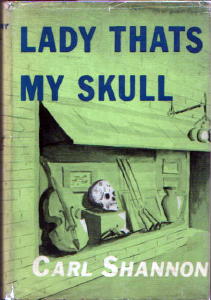 The plots of Phoenix
mysteries, too, are unusually
interesting. Take the following, for instance: The plots of Phoenix
mysteries, too, are unusually
interesting. Take the following, for instance:Robert D. Abrahams’s Death in 1-2-3. Murder strikes the New York consulate of a small South American republic, and there develops such inspired stuff as secret societies and daggers with coded numbers engraved on them. The story is narrated in the present tense by a private eye who has all the wit and charm of Calvin Coolidge, and that nobody leaves the consulate for more than three pages at a time or does much except talk only adds to the fun. In no other mystery can you read until page 73, skip to page 203, and feel that you haven’t missed a single plot thread. Louis Trimble’s Murder Trouble. A slam-doozy (as they used to say) about headless corpses, corpseless heads, a hero who prefers to spend his wedding night digging up dead people, a dynamited outhouse on a snow winter’s eve (I wouldn’t take that sitting down), and the smuggling of nylon stockings across the Washington state border from Canada. Murder with Long Hair by H. Donald Spatz, a one-time radio writer. All that needs to be said about this one is to quote the dust-jacket blurb [this was not the book’s blurb; it was taken from Phoenix promotional material]: “Steve Daniels and his beautiful blonde bride attended a summer stock performance in the Poconos starring Jessica Sanford and were invited by Jessica’s friend, editor Edison Cushing, to join his house party, where Jessica was found drowned in the lily pond.” The Case of Mr. Cassidy, by William Targ and Lewis Herman. In which amateur criminologist and “connoisseur of incunabula” High Morris becomes enmeshed with bibliophiles (one of whom is renowned writer and Sherlockian Vincent Starrett), a first edition of Poe’s Tamerlane, and a “notorious and uncaptured Chicago throat-cutter” called the Fiend. As detective Morris says about the atmosphere of a certain nightclub: “It’s an illusion, like the slowed-up speed in a marijuana dream. It’s all an enormous hashheesh hallucination, blossoming with gorgeous non-existent blossoms, fragrant with odors unknown to any perfumer, sonant with the crashing, melodic chords of a thousand piece orchestra, peopled with moon-breasted houris reclining languorously on cloud-quilted divans.” It certainly is. Robert Portner Koehler’s Murder Expert. A gaggle of mystery writers, including the female narrator (males without the talent of a Cornell Woolrich should never try to write first-person females), are gathered at a party, and some of them are subsequently murdered in various way. It is not so stated, but one gets the impression that each of the victims wrote for Phoenix Press. The Purple Pony Murders, by Sidney E. Porcelain. Characters with such names as Breeze, Clay, and Kite populate this thrilling racetrack yarn, which has a little bit of everything, including French lessons (“‘Oui. Always eet waz Martini and Crème Yvette een ze leetle ponee avec biscuits.’”) and a couple of the most improbable horse races ever run (“Murder is like a horse race. You start out with a lot of suspects, you look into their records, but you never are sure which one of them is the winner, or as it happens, the murderer. A dark horse you didn’t think of might be the one who crosses the line!”)  Murder Goes South, by Amelia Reynolds Long. Woman mystery writer Peter Piper solves a series of antebellum slaughters in Louisiana and in the process, uncovers more misinformation than you ever wanted to know about voodoo and cypress swamps. This is so full of Stepin Fetchit blacks and thinly veiled racism that it easily wins the Most Objectionable Phoenix Mystery award. The Case of the Little Green Men, by Mack Reynolds. In which members of a science-fiction fan club are being terrorized and/or murdered by – it is alleged – little green men who have landed on earth. The hero, a jaded private eye, takes the case, reads a little science fiction to acquaint himself with the background, becomes hooked, and – it is inferred – immediately subscribes to every magazine in the field. He also solves the case, and it should surprise no one to learn that it was not little green men after all but a cunning human being who perpetrated the crimes. Carl Shannon’s Lady, That’s My Skull. The opening paragraphs of this one read as follows: “The desk calendar said March twenty-fourth. It could have said any other day and the same thing might have happened. That is, I could have become mixed up with the painted skull. Still, if I had just skipped March twenty-fourth – say been on a big party and not sobered up – maybe I would have missed a lot of unpleasant things. Well, I didn’t miss March twenty-fourth, so I didn’t miss the damned skull or the trail of violence along which it gyrated.” What happens after that involves the skull, which the lawyer-narrator finds in a pawnshop and which bears not only the letters of his old fraternity but the fingerprints of a gangster supposedly dead for years; a murder, a twenty-thousand-dollar necklace, a Chinese valet named Chan, and a watering hole called the Donkey Room (wherein the hero makes an ass of himself – naturally). All the Phoenix mysteries heretofore discussed are either minor classics or near-misses; none quite achieves the unqualified classic status of two others, both published in 1941: Murder at Horsethief by James O’Hanlon and Death Down East by Hayden Norwood. These two mysteries are totally unlike each other, and yet each in its own way epitomizes the Phoenix mystique. The first, Murder at Horsethief, is the masterwork of former Hollywood scriptwriter and self-styled humorist O’Hanlon. It took him four other novels (three for Phoenix Press, one of which deals with a racehorse named Disaster that eats potted geraniums) to reach the lofty heights of Murder at Horsethief. It may be conjectured that the reason O’Hanlon wrote no more mystery novels after this one is that he knew he had reached the limit of his talent and would be unable to surpass himself. Few writers can lay claim, after all, to more than one classic in a lifetime. 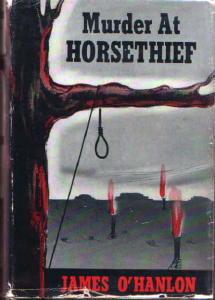 Set in an Arizona desert
town near which gold has
been discovered (again) in 1940, it concerns itself with a crooked
saloon owner who was once a mobster in Los Angeles, a group of
entertainers known as Frankie Sparrow and his Seven Canaries, a Mexican
who is almost hanged by a group of drunken miners after being falsely
accused of murder, a tribe of Malooga Indians who live in the nearby
mountains and say clever things like “How” and “Ugh,” a group of
vigilantes who wear flour-sack hoods and call themselves the Haunts of
Horsethief, and the inimitable detective team of Jason and Pat Cordry,
who were once extras in Hollywood but who are full-fledged stars in the
firmament of southern California lunatics. Set in an Arizona desert
town near which gold has
been discovered (again) in 1940, it concerns itself with a crooked
saloon owner who was once a mobster in Los Angeles, a group of
entertainers known as Frankie Sparrow and his Seven Canaries, a Mexican
who is almost hanged by a group of drunken miners after being falsely
accused of murder, a tribe of Malooga Indians who live in the nearby
mountains and say clever things like “How” and “Ugh,” a group of
vigilantes who wear flour-sack hoods and call themselves the Haunts of
Horsethief, and the inimitable detective team of Jason and Pat Cordry,
who were once extras in Hollywood but who are full-fledged stars in the
firmament of southern California lunatics.The plot (or lack of one) is only one of the reasons that Murder at Horsethief is a tour de force. Another is that what O’Hanlon considers funny generally isn’t, but most everything else is. O’Hanlon, you see, delighted in concocting phonetic and idiomatic dialogue. Everybody, including Jason and Pat, drops his g’s and says “ain’t” and butchers the English language in all sorts of fascinating ways. Some sample Western-miner dialogue: “In a coupla minnuts, Gents, yer gonna see with yer own eyes whut brand o’ law we tends t’ practice in Horsethief! Whut happens t’ this heah Mex is gonna happen t’ any white-livered coyote who gits notions ’bout ashootin’ decent citizens in anythin’ but a faih and squaih fight!” Some sample Indian dialogue: “Come catchum smoke. Chetterfiel ceegret. Come back byeumbye aftah braves makum powwow wit’ Lomitaha.” Some sample mobster dialogue: “Dey calls dis a funeril! Say, boss, remember the one we give t’ Snuffy Dolin, back in Chi? Now dere was a send-off!” Some sample Western-preacher dialogue: “Brethren . . . and sistern . . . we are gathered heah t’ give decent burial t’ our departed friend an’ brothah, Doc Thayah. Y’all knowed Doc t’ be a might good man, which is more’n we kin say fer the murderin’ skink what plugged him! The Good Book sez ‘Fergive us our trespissis like we fergives them what trespissis ag’in us.’ By the way, lambs o’ the flock,” the gentleman deviated, “come Sunday, Ah’m preachin’ a powerful pregnant sermon on thet subjeck of trespissin’, in the Hossthief Theater, an’ Ah wan’s y’all t’ be theah! Brothah Herman’s Happy Harbor is mah new name fer the place, an’ in it Ah inten’s t’ do a lotta soul-patchin’!” Some sample Jason Cordry dialogue: “Oo wanna make popsie-wopsie fweel very sad an’ sowwy? Tell popsie-wopsie oo fwogives him, or popsie-wopsie cwie!” Some sample Pat Cordry dialogue, 1: “Momsey do no want popsie-wopsie to cwie. Momsey fwogives popsie-wopsie an’ fwows him a big kissie-wissie!” Some sample Pat Cordry dialogue, 2 (after she and Jason have heard strange music being played): “It ain’t swing!” Pat popped. “Sounds like their [sic] cutting a rug to wrap a corpse in. . . .” O’Hanlon’s descriptive prose is brilliant, too: Pat was horrified. Her stomach became a
fun-house of activity and her lower lip went into motion seconds before
she was able to squeeze a sound past her lips.
Jason’s stomach slapped against his backbone. Beside him, Pat had become one hundred and four pounds of concentrated gloom. A moon, from which some heavenly force had taken a huge bite, and to which a faraway coyote was paying wailing tribute, hung over Horsethief. A sudden thought bounced her heart to her larynx. About ten yards away, seated atop a horse beneath a large, solitary tree, Pat’s bulging eyes located the gentleman for whom the “party” was being thrown. Murder at Horsethief, it may be said, is one of those cheerful romps, full of chuckles and guffaws, and a malooga or two. Hayden Norwood’s Death Down East, on the other hand, is a considerably more sober, if no less stunning, effort. Norwood’s novel – he also wrote the equally stultifying They Met at Mrs. Bloxon’s – is set in a place called Hallowdale, Maine, and among its plot components are a bloody ax, a dead chicken, a wicked lady named Mrs. Ciccone (all people with Italian and other ethnic names are wicked in Phoenix Press books, except maybe for Duke Pizzatello), a missing minister, a missing town drunk, and a “hero” who goes by the name of Macbeth Archer. These elements do not have a great deal to do with the book’s classic status, though. What makes it a tour de force is the fact that in its entire 256 pages, nothing happens. 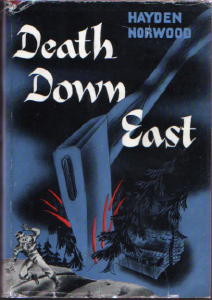 Nothing. Happens. There is no plot development, there is no characterization, there is no mystery (except why Norwood wanted to write it in the first place). Reading it, one keeps waiting for something to happen; one expects some sort of action, excitement, maybe even a “hell” or “damn” to liven things up; one thinks that perhaps he will be surprised or at least titillated by the ending. Nothing. The most exciting occurrence in the book is Macbeth finding the dead chicken. There is one other scene that has potential: Macbeth goes to confront Mrs. Ciccone, and she makes a vague pass at him; but he is clearly asexual, if not a eunuch, and he goes away from her shaking his head in a puzzled fashion. Here are some examples of Norwood’s artful prose: “The train’s late,” observed Macbeth. He
drew out his watch. “Three minutes past six. Three minutes
late. How’s that for close observation, Oscar?”
“You should of been a detective,” said Waddell, “instead of a soda jerk.” Penny was waiting just inside the door, and her arms were around him suddenly, startling him. “Did I frighten you, Mac?” “No. I involuntarily jump like that every now and then. Maybe it’s because my mother tied up my thumb when I was a baby to keep me from sucking it.” “I’m sorry I burst in this way,” said Macbeth, “but axes with blood on them don’t turn up every day. I wanted to ask Sheriff Redburn what to do about it. You see, there’s human blood on the axe.” “Is that any concern of mine?” asked Dr. Ashcraft curtly. “Is it any concern of the sick man here? Don’t you realize that you’ve been made deputy sheriff to handle infringements of the law and order, and not to make a nuisance of yourself? A bloody axe, did you say? It doesn’t appear to me that that’s a matter of any importance.” “I’m sorry,” said Macbeth. He went to the door. Foreboding gnawed like a cancer in Penny’s bosom, and when she went to bed that night she was sure she wouldn’t get a wink of sleep. But she did fall asleep, soundly, almost immediately upon resting her cheek upon the pillow. She was astonished to open her eyes and see the light of day. Macbeth entered his mother’s house by the back door. He could hear his mother and Penny in the parlor talking. He went down into the cellar and brought up the head of the Leghorn hen as well as the carcass. He heard his mother say in a frightened voice, “There’s somebody in the kitchen!” Mrs. Archer and Penny stood in the doorway, staring at him. “Heavens, Mac!” cried his mother. . . . Macbeth grinned. “Say, this chicken is perfectly preserved,” he said, “in spite of the fact that it’s been dead for almost a week. Speaks well for the coolness of your cellar, Mama – and with cold weather coming on, it wouldn’t surprise me if the carcass and head last for months without beginning to smell.” Phoenix Press, I love you! (From Gun in Cheek: A Study of “Alternative”
Crime Fiction
by Bill Pronzini, published by Coward, McCann & Geoghegan,
1982. Reprinted by permission.)
|